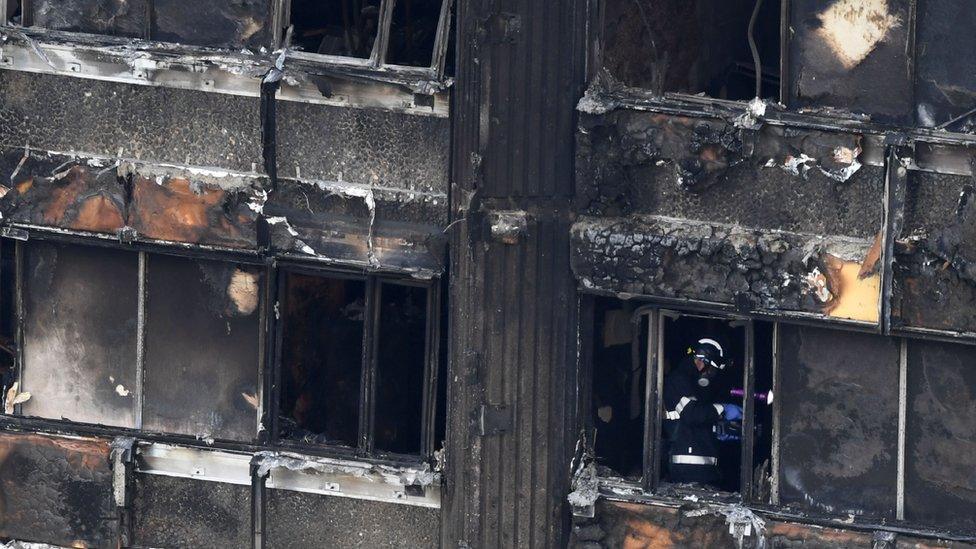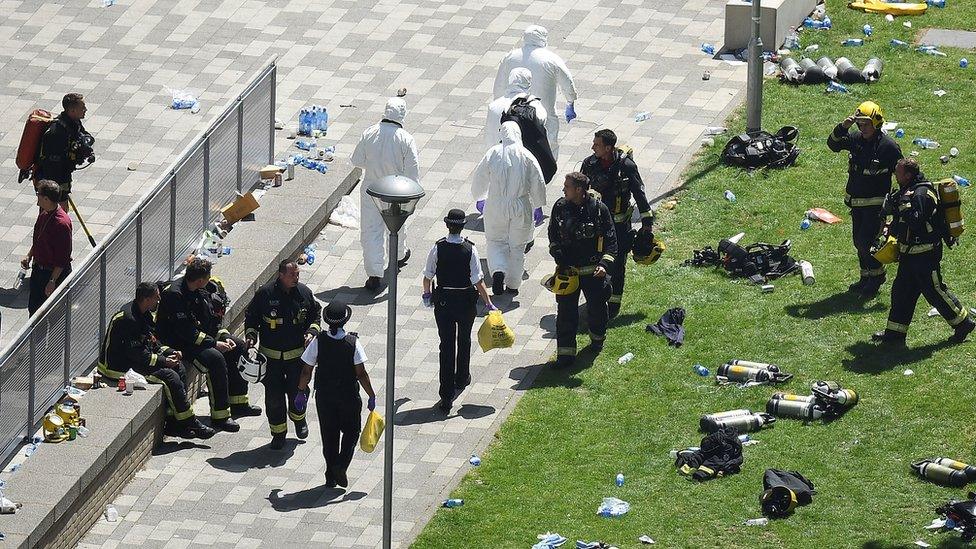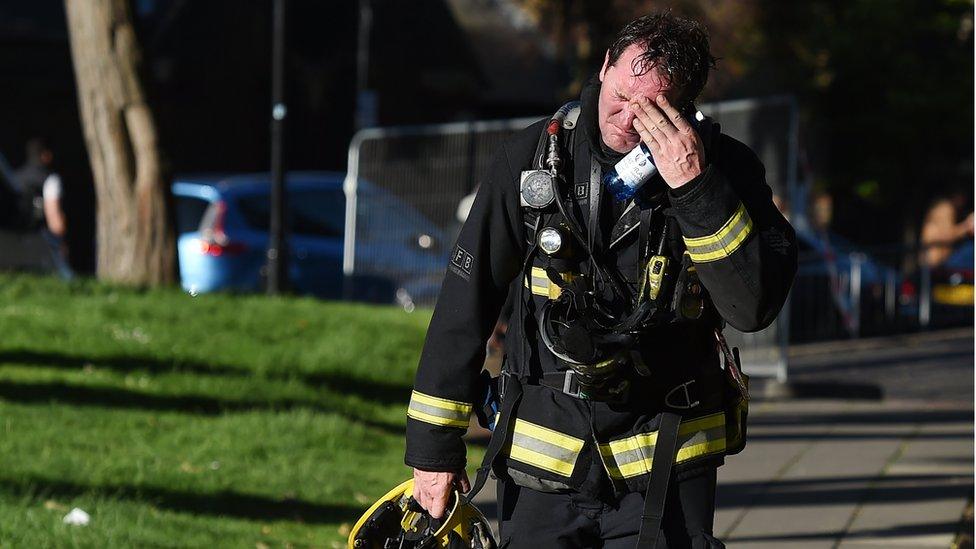The painstaking task of naming Grenfell's victims
- Published

Relatives of those who died in the Grenfell Tower tragedy are angry at the time it's taking to recover and name victims. But police and forensic science experts say the process of identifying severely fire-damaged remains is a highly complicated one - and it will take some time before families can know the fate of their loved ones.
On Tuesday night, tempers flared in a closed-door meeting as survivors of the Grenfell Tower disaster demanded to know why the police and coroner weren't able to give out more details about those still missing.
So far, 21 people have been formally identified as having died in the fire and their families informed. But police believe at least 80 were killed. Met Police Commander Stuart Cundy has said there have been a total of 87 "recoveries" but, due to "catastrophic damage" inside the building, that did not mean 87 people.
Some residents suspect the figure could be even higher, and the slow pace of progress has fuelled fears of a cover-up.
The distress and frustration felt by survivors as a result of the delay is understandable, especially given that police have said the final death toll will not be known until the end of the year.
But experts in the specialised field of victim identification say this fire is a particularly challenging disaster and, that despite fears that the job is not being done properly, the UK has one of the best identification systems in the world.

Police, firefighters and forensic science teams outside Grenfell Tower
"We need to make sure by scientific means," says the UK's Disaster Victim Identification Co-ordinator, Det Supt Alan Crawford. "That's why it takes longer to get identification, but then and only then, when we are 100% certain, do we tell the family."
Scotland Yard says all "visible human remains" have now been removed from the building. Specially trained officers and forensic anthropologists will continue to sift through more than 15 tonnes of debris on each floor by hand in the hope of finding other human material.
Disaster victim identification (DVI) is a police discipline that has developed out of lessons learnt from dealing with incidents of mass casualties around the world.
Every airplane crash, terrorist bombing and natural disaster adds to the collective sum of knowledge around issues - such as where to locate a temporary mortuary, how to collect and categorise fragmented remains and what the most accurate method is to identify them.
The practice is regulated internationally according to Interpol standards, adhered to by 197 countries.
In the UK, a pivotal moment in disaster victim identification came after the 1989 Marchioness boat tragedy in the Thames, in which 51 people died.
Eleven years after the Marchioness sank, a public inquiry was ordered to look into the work of the coroner after relatives complained they were kept in the dark, prevented from seeing bodies and that the hands of some victims had been removed unnecessarily for fingerprinting.

Victims' families complained they were kept in the dark after the Marchioness disaster
"The inquiry made a number of recommendations, principles we hold true now," says Det Supt Crawford.
"Avoid misidentification at all costs, treat the deceased with respect and dignity, be open and honest with families at all times and give as much information as we can."
In the UK, there are now around 2,000 police officers throughout the country who have volunteered for specialist DVI training in addition to their normal duties. They can be called on at any moment.
"We're up there in relation to being one of the best in the world at what we do," says Det Supt Crawford.
"We lead a lot of countries and they seek our advice."
When a disaster like Grenfell Tower happens, there are two distinct strands to the process of identifying victims.
One is gathering as much information as possible about potential victims from relatives, and friends, including collecting medical and dental records.
On the morning of the Grenfell Tower fire, the number for a Casualty Bureau phone line was given out the media. Members of the public who called in were asked a number of specially scripted questions designed to prioritise those with information about potential victims.
Those deemed likely to know someone caught up in the fire were allocated a family liaison officer who logged details about the missing person onto an official Interpol form.
The other strand of identification involves collecting information from the bodies themselves. This work is led by a senior identification manager (SIM), who appoints a scene evidence recovery manager, or SERM, who in turn oversees the work of DVI-trained body recovery teams.
These teams log every detail before moving them to a designated mortuary.

"At that time, we don't know who we are recovering so it's really important we recover the body or human remains in a dignified manner," says Det Supt Crawford.
"We need to make sure it's photographed, there's a continuity of evidence, there's a forensic preservation and all the way through that process from body recover to being lodged at the mortuary is done to a judicial standard."
When bodies are brought into the mortuary, experts try to identify them according to standards set by Interpol.
This means identification must be made using dental records, fingerprints or DNA. Medical implants that carry serial numbers such as pacemakers or hip replacements can be used as secondary identifiers, as can scars, marks and tattoos.

Visual identification by relatives is not used because this is regarded as unreliable. Nor is the discovery of property on a body, such as bag or purse.
Det Supt Crawford cites a 2006 case in the US where five college students were killed in a minibus crash. One family was told their daughter had died, after her body was identified from the bag she was found with. In fact, she had survived and was heavily bandaged in intensive care being watched over by another family whose daughter had been killed in the crash. It was several weeks before the mistake was discovered.
In the case of Grenfell Tower, there are several factors complicating this identification process.
The first is that the fire is what's referred to as an "open" disaster. A "closed" disaster is a situation such as a plane crash, in which a manifest exists of all the passengers and crew. In such a case, identification is a relatively straightforward case of matching the dental records of those on board with the victims.
Open disasters are more difficult. Here, investigators might have an idea of who was present, but do not know conclusively, making it hard to collect references for DNA, fingerprints or dental records.
Although the police have a list of those missing and presumed dead from the fire, they still have no information on the inhabitants of 23 out of the 129 flats in the building.
The Metropolitan Police says it is working with the Red Cross and community groups to spread their message of an amnesty for illegal immigrants, as well as those illegally sub-letting, so more potential victims can be identified.
The intensity of the fire also poses an immense challenge to forensic experts. The Westminster coroner, Dr Fiona Wilcox, is reported to have described the scene inside the burnt-out tower block as "apocalyptic".

Dr Denise Syndercombe-Court is a forensic scientist at Kings College London who works with the Metropolitan Police. She says experts will have to rely on new, sensitive techniques to analyse the remains. It's a slow and painstaking procedure.
"In some cases, these bodies are so badly damaged by the heat - terrific heat temperatures - we literally will have fragments of bones," she says.
"We'll work on providing strategies for what material is suitable for what analysis technique."
Knowing where the remains have been found is a key part of solving the identification puzzle. That is why it is so important for the DVI-trained body teams to log every detail before the body is moved.
"There's no point analysing material if you have no idea where it came from," says Dr Syndercombe-Court.
When the World Trade Center towers collapsed on 9/11, human remains were fragmented and mingled in among the debris of the buildings. As a result, 40% of the victims have still not been identified.
If DNA can be extracted, it then needs to be matched with that of potential victims. Here again, the ferocity of the fire poses additional challenges as surrogate samples of DNA, such as from personal items or toothbrushes, will have also been destroyed.
Because many of the victims were immigrants, investigators may need to work with police forces in other countries to collect DNA from at least two family members - all of which takes time.
The process can also take a huge emotional toll on those carrying it out.

Forensic scientist Prof Peter Vanezis is a veteran of identification investigations, including working on mass graves in the Balkans.
"There were some people who weren't very keen on being counselled," he says of his time in Kosovo. "They were the ones who were really affected because they thought they were being very macho by not worrying about these things, but they do get to you."
Det Supt Crawford says that officers who volunteer for DVI-duties are monitored and offered counselling because of the traumatic nature of the work.
It's only when the coroner is satisfied that the information provided about the missing person from relatives, dental and medical records matches that taken from the remains that a formal identification can be made.
This can be an extremely slow process.
"There might be an awareness of how long it takes if one sits down and thinks about it in the cool light of day," says Prof Peter Vanezis, who was part of the team who identified the final Kings Cross fire victim, 20 years after the disaster.
"But when you're dealing with relatives who are bereaved or waiting to find out what happened, frustration comes along very quickly."

Join the conversation - find us on Facebook, external, Instagram, external, Snapchat , externaland Twitter, external.